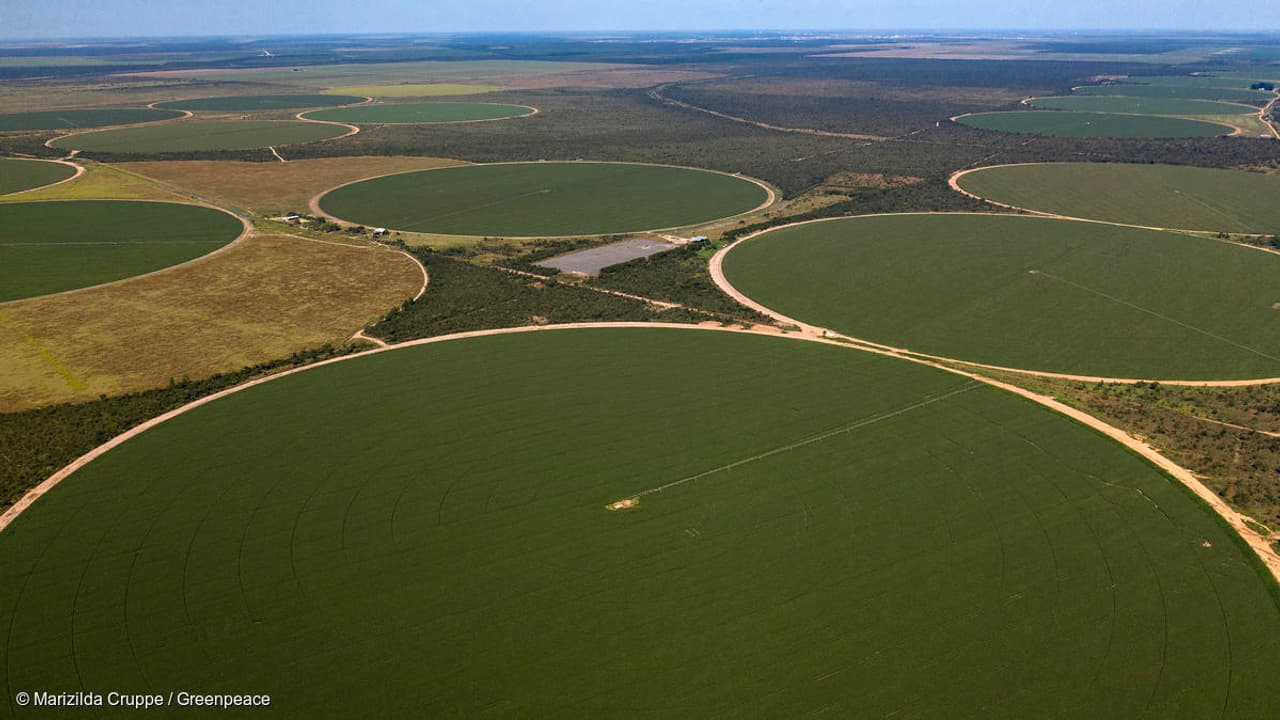
Cargill: the company feeding the world by helping destroy the planet
It's a controversial corporate giant that transformed how we eat and has the global food industry in its grip. So why haven't we heard of it?
When it comes to explaining the impact of America’s second biggest private company on your life, no one puts it better than the company itself.
“We are the flour in your bread,” says one of Cargill’s corporate brochures, “the wheat in your noodles, the salt on your fries. We are the corn in your tortillas, the chocolate in your dessert, the sweetener in your soft drink. We are the oil in your salad dressing and the beef, pork or chicken you eat for dinner. We are the cotton in your clothing, the backing on your carpet and the fertiliser in your field.’”
In its 155 years, Cargill has insinuated itself into almost every aspect of global agribusiness, transforming the way human beings produce and consume food. It has made its owners into billionaires. And its ascent has played out to a steady backdrop of controversy, most recently the revelation that its supply chain has been linked with vast deforestation – related to extensive fires – in Brazil’s crucial Cerrado region. It is the latest in a string of scandals affecting Cargill including fatal food poisonings, deforestation, agricultural pollution and allegations of child enslaved labour.
Cargill is as controversial as it is enormous – and yet you have almost certainly never heard of it. How, then, has this corporate juggernaut managed to keep such a low profile? And what has it been doing while the rest of us have been looking elsewhere?
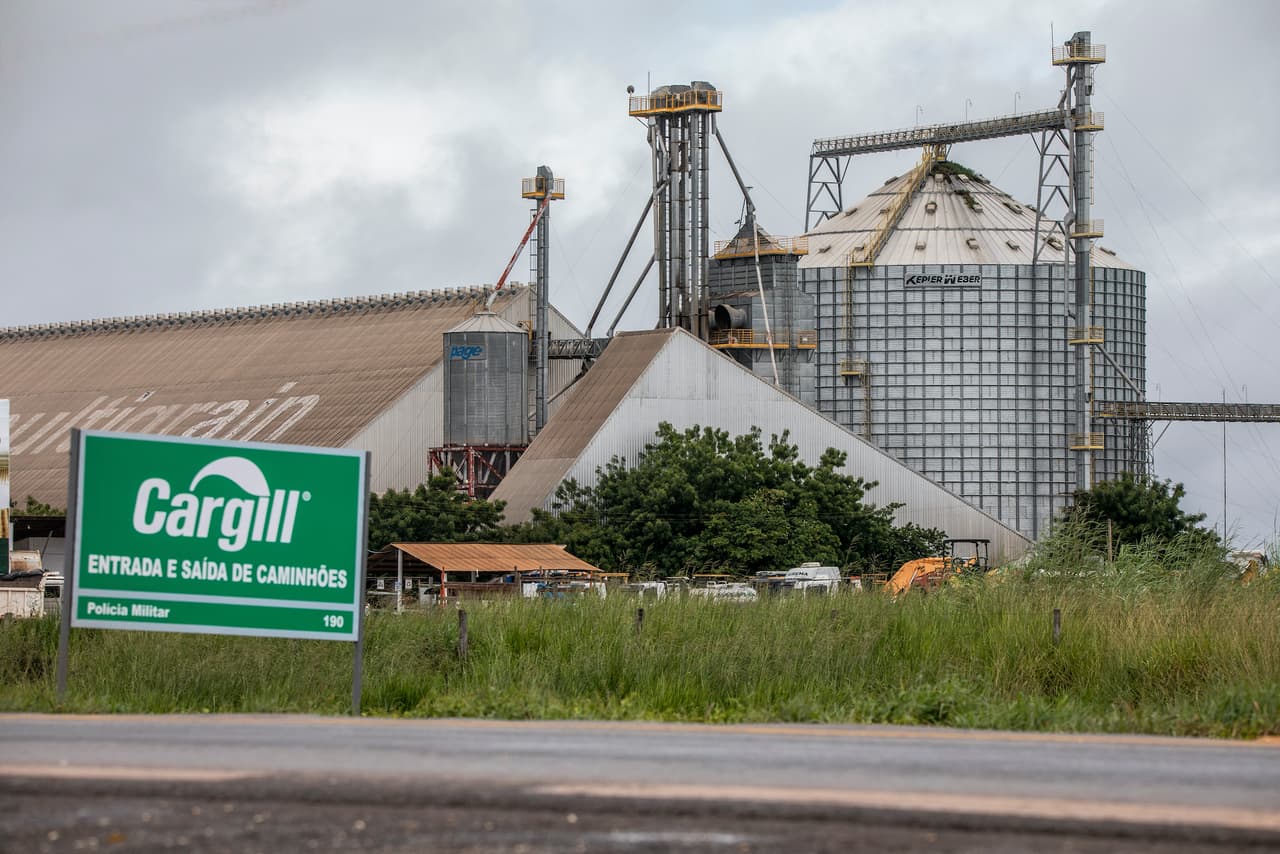
Building a behemoth
William Wallace Cargill founded Cargill in 1865, buying a single warehouse at the end of a new railway line in Iowa. As the great plains emerged as America's breadbasket, he saw the potential for profit by acting as a middle man between farmers and customers, perhaps even expanding along the new railroads that were pushing into Wisconsin and Minnesota.
As the company grew, Cargill’s was often the only grain elevator at the major railroad stations, leaving farmers little choice but to accept its prices – which had sometimes been fixed in backroom deals. Such questionable ethics helped Cargill increase in reach and in scale: by the turn of the century the company handled coal, flour, feed, lumber and seeds. It had invested in railroads, land, water irrigation and farms.
The company faced its first major scandal during the first world war, when it was accused of wartime profiteering. In the late 1930s, when drought and over-plowing transformed the great prairies into the dust bowl, Cargill was suspended from the Chicago Board of Trade for buying up corn futures, allegedly to corner the market.
Yet still the company grew, and at bewildering speed. Boosted by lucrative government contracts during the second world war, Cargill’s US grain exports increased 400% between 1955 and 1965, with annual sales rising to $2bn. As it accumulated capital, the company began the MO of discreet but ruthless expansion that it would come to be defined by.
By this point Cargill was a global player in commodity markets. But its move into food processing in the middle of the 20th century transformed farming in America – and across the world – beyond recognition.
Over the past 50 years, agriculture has become dominated by a few major crops such as wheat, maize and soya, said Erik Millstone, professor of science policy at the University of Sussex. “The extent to which Cargill drove it is … difficult to ascertain, since so much of their trading was opaque,” he said. “But they have made good business out of it … they played a dominant role in narrowing and homogenising plants around the world.”
The industry’s shift towards cheap commodities produced on vast acreages at very high volumes was pivotal. Since the 1980s it has spread globally, pushing out family farms all over the world and benefiting big traders such as Cargill above all.
“It used to be that if you were buying a chicken or some beef, you'd get it from farms within a hundred miles of your city,” said Glenn Hurowitz of the environmental organisation Mighty Earth. “Now the meat and the feed can be shipped thousands of miles, with no visibility of how it's made … Cargill has built the modern agriculture system – with all its abuses.”
A spokeswoman for Cargill said: “Cargill is committed to nourishing the world in a safe, responsible and sustainable way.”
By 2008 the operation that started as a single frontier outpost in Iowa had become one of the largest privately held companies in the western world. Today it employs roughly 155,000 people in 70 countries. Its fleet of 570 ships move 200m tonnes of commodities every year. Cargill’s political and economic intelligence on food and agriculture has even been said to exceed that of the CIA.
But above all Cargill is notable for its secrecy. The Cargill family, 14 of whom are billionaires, still own 88% of the corporation, giving the company a powerful cloak of invisibility: it’s almost entirely up to Cargill how much it chooses to share with the public.
“A vast proportion of the world's main agricultural commodities pass through the hands of just four international trading corporations,” said Millstone. “Cargill is one.”
Where food is sweetened, preserved, emulsified, milled or imbued with additives, there is Cargill. And it is present throughout various stages of the process, meaning it can dominate across sectors.
Join the fight for public interest journalism!
The Bureau is entirely funded by foundations and readers like you who want a fairer and more democratic society for everyone. Support us today so we can share more stories like this.
With soya, for instance, Cargill might buy beans from Brazilian farmers, store them in a Cargill silo, take them across the ocean in a Cargill-leased ship to a Cargill feed mill, then truck the resulting animal feed to a Cargill-contracted chicken farm.
Avara – Cargill’s joint-enterprise in the UK with Faccenda foods and the banner under which its chicken farms operate – supplies chicken to Tesco, Nando’s and McDonald’s. But there is no reason that anyone buying a fillet of “British chicken” or tucking into a McChicken sandwich would know that an American corporation had been involved at almost every step – or that swathes of Brazilian woodland had likely been flattened in the process.
This near-invisibility is no accident, said Michael Lansing, an environmental historian. “It’s hard to imagine a consumer boycott of Cargill, [although] obviously environmental groups have tried,” he said. “Because when I go to the grocery store, where do I see Cargill?”
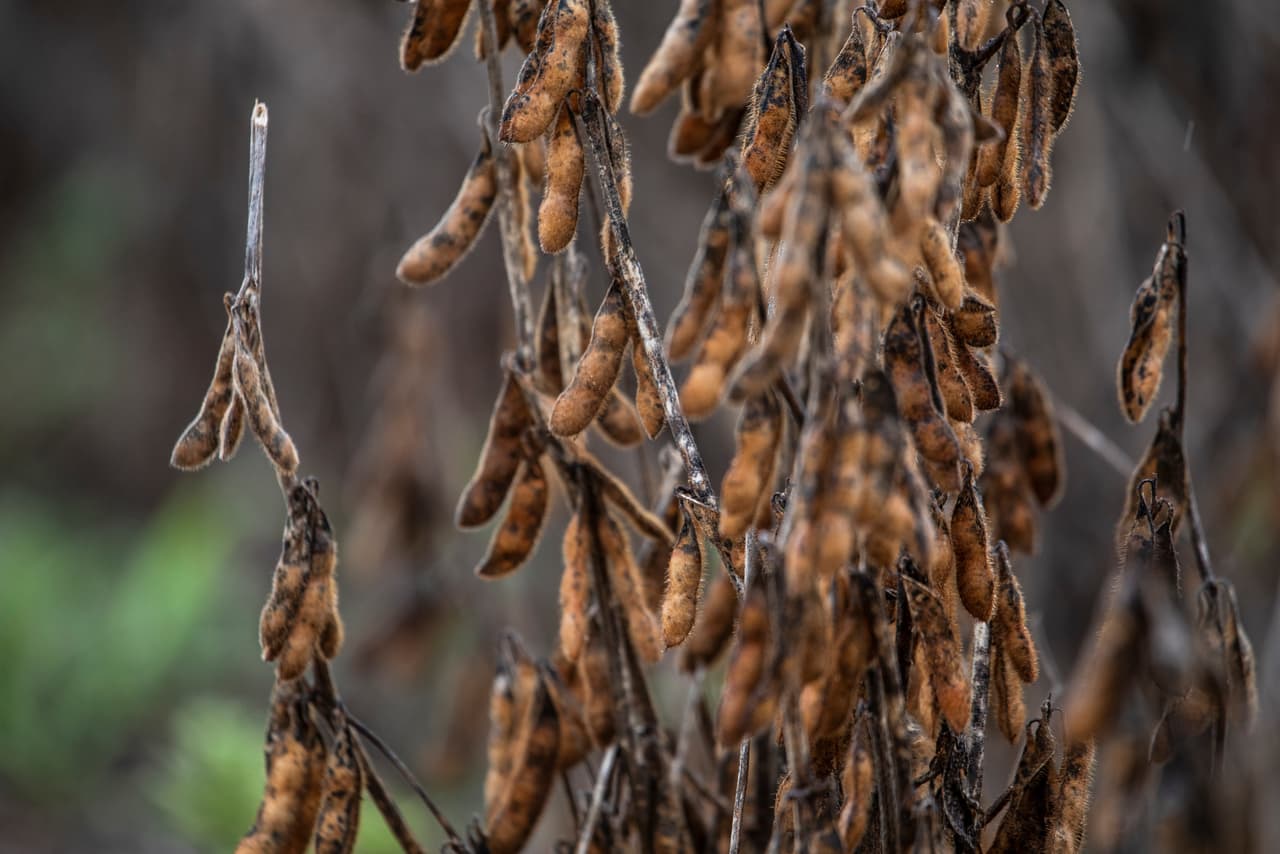
Sourcing soya
There was a period, about a decade ago, when Cargill’s environmental record in Brazil seemed to be improving. In the early 2000s, deforestation rates in the Amazon were shocking: an area the size of Hawaii was cleared in 2004 alone. In 2006, following a Greenpeace campaign, Cargill and other major soya buyers – along with their customers such as McDonald’s – agreed not to trade in soya beans grown in newly deforested areas of the Amazon. The “soya moratorium” is seen as a huge success: Amazon deforestation dropped steeply and Cargill was lauded for its role.
But soya is big business in Brazil – the country produced almost 118m tonnes of it in 2018 – and behind the scenes the trade continued to boom. How? The moratorium had simply traded the destruction of one ecologically crucial biome for another: the Cerrado, a sprawling tropical savannah with far weaker protections. Between 2008 and 2012 the rate of forest loss in the Amazon slowed by 67%. But the Cerrado continued to disappear at alarming speed: in the decade to 2018 it lost 95,000 sq km of land, 66% more than the Amazon – which is three times the size.
The Cerrado is a crucial ecosystem. It contains 5% of the world’s plant and animal species. It is also a huge carbon sink, stabilises the regional climate and is critical for eight of Brazil’s 12 river basins. And it is integral to the national energy supply: 80% of Brazil’s electricity comes from hydroelectric power plants on rivers whose sources lie in the Cerrado. More than half of the Cerrado’s native vegetation is already gone. Much of what remains is dangerously fragmented.
Cargill has not only resisted an Amazon-style soya moratorium for the Cerrado – despite calls from customers such as Tesco and McDonald’s – but, according to campaigners, it has encouraged competitors to do the same. “The other traders will follow Cargill’s lead,” Hurowitz told Unearthed.
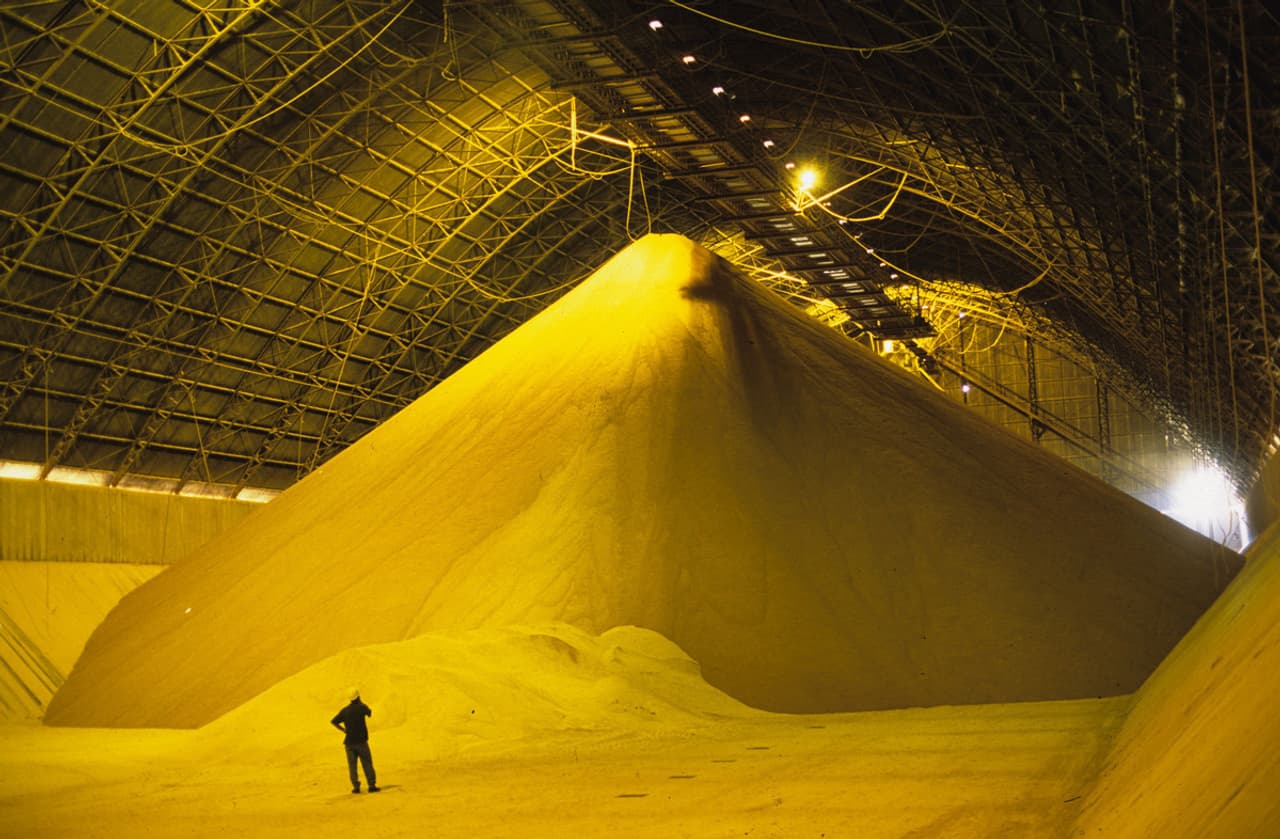
A moratorium would not end soya farming or even block its expansion – the Cerrado has plenty of degraded land, mostly former cattle pasture, that could be renewed for the purpose.
The Cerrado, with its vegetation estimated to store the equivalent of 13.7bn tonnes of carbon dioxide, is seen as vital in the global battle against climate change – a battle for which Cargill has expressed public support. It set targets to reduce its emissions by 10% by 2025. Last July, it pledged to cut greenhouse gas emissions from its US beef supply by 30% over the next decade. Yet the Cerrado, if left as natural savannah and forest, acts as a huge carbon sink.
Ten years ago, Cargill set itself a deadline of ending deforestation in its supply chains by 2020. Last year it admitted it would miss that deadline. It now has a target of 2030. Even so, people on the ground in Brazil say that there is little sign of any such changes being enacted.
“We see big, grand communications outside, at tables at big international events, but what we see in the field is completely different,” said Isabel Figueiredo, a Cerrado ecologist at the Institute for the Society, Population and Nature. She believes there is an insufficient connection between what Cargill says and what it promotes in the plantations.
One Cargill supplier in the Cerrado told Unearthed that while soya producers throughout the region were increasingly aware of international pressure over deforestation, Cargill had never talked to him about sustainability, nor audited his properties.
Hurowitz said that he was sceptical of claims that soya supply chains were too complex to properly monitor, given that Mighty Earth has in the past presented Cargill with clear examples of deforestation in their supply chain. He said Mighty Earth “have done Cargill’s homework for them” but the company still has not acted adequately.
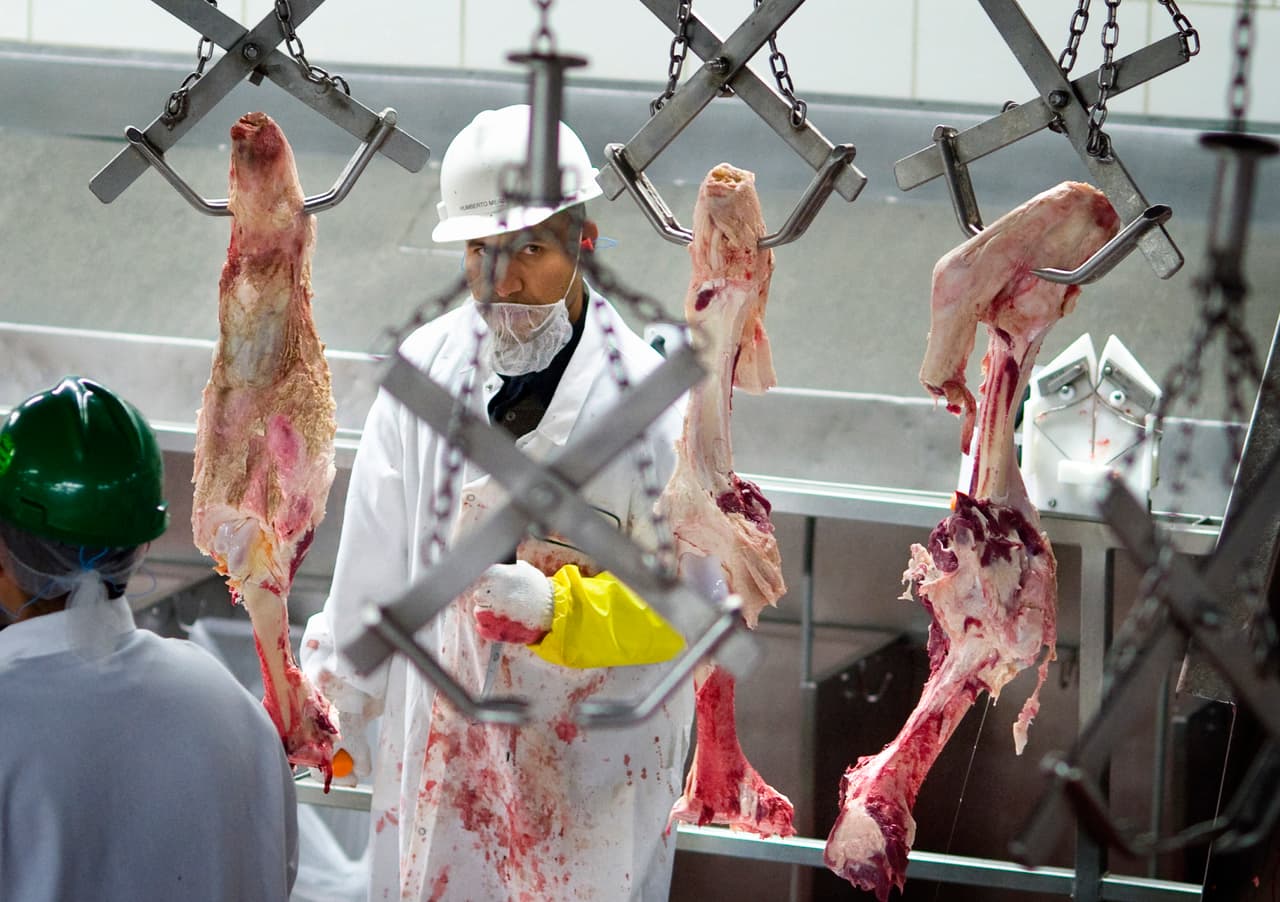
Concerns about Cargill
Away from its soya operation, Cargill is also one of the world’s top three meat packers – a practice where missteps can be fatal. In 2000, seven people died, 29 were sickened and three women had stillbirths or miscarriages linked to a listeria outbreak in sliced turkey from a Cargill processing plant in Texas. The same year, a three-year-old girl died and 140 others became ill after eating E coli-tainted meat supplied by a Cargill meat-packing plant that had a number of previous citations for faecal contamination. A salmonella outbreak across 37 states in 2011 resulted in another death linked to Cargill-processed meat.
In 2009, the New York Times reported that Cargill-supplied hamburgers contaminated with E coli had been made from a mish-mash of cheap scraps more likely to have contact with faeces, some of which had been doused in ammonia to kill bacteria. The process saved Cargill 25% in costs but left one consumer paralysed from the waist down.
At the time, a Cargill spokesperson told the New York Times: “We are committed to continuous improvement in the area of food safety.”
Even though safety protocols are generally followed, the industrialised meat industry in the US is more prone to outbreaks than in Europe, largely because livestock densities are higher and hygiene standards lower.
Antibiotics are used liberally, not just to treat unwell livestock but to stop infections developing at all. Using antibiotics in food production enables bacteria to develop resistance, meaning the drugs will be less effective in humans. Antibiotic resistance is one of the gravest global public health threats, estimated to kill up to 700,000 people each year.
Cargill publicly states that it “supports the prudent and responsible use of antibiotics to help ensure a safe, nutritious and affordable food supply worldwide” and that it is “committed not to use antibiotics that are critically important for human medicines as defined by the World Health Organization”. However, in 2018, a Bureau investigation found that samples from animals slaughtered in Cargill meat-packing plants revealed 11 different antibiotic substances that had been in use within the company’s supply chains - including three classified as being critically important to human health.
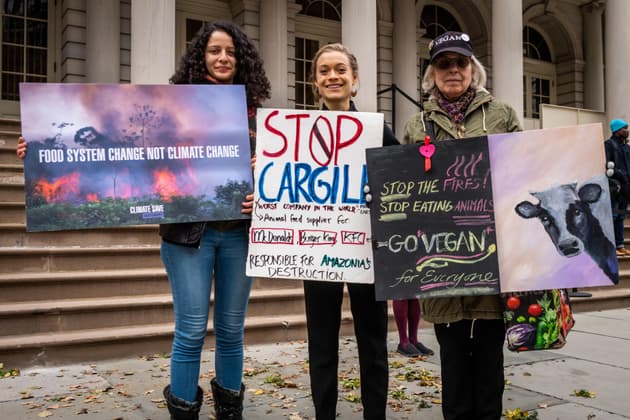 Protesters outside City Hall in New York, 2019.
Pacific Press Agency/Alamy
Protesters outside City Hall in New York, 2019.
Pacific Press Agency/Alamy
Meat industry representatives told the Bureau it was impossible to make meaningful conclusions from the data. The samples only indicated the presence of antibiotics, they pointed out, with no information about why they were administered. Sometimes it was necessary to use critical antibiotics, they said, and all drugs used were approved for use in animals.
Cargill has also violated various US environmental laws in recent years. Noxious waste from hog farms and fertiliser plants has been spilled into creeks and streams, including in Missouri and Illinois and bays around San Francisco, killing countless fish and fouling up wildlife refuges, wetlands and reserves.
Mighty Earth documented these issues, along with many more, last summer in a report that was highly critical of Cargill – in response to which the Cargill CEO, David MacLennan, has made pledges regarding future action in relation to deforestation.
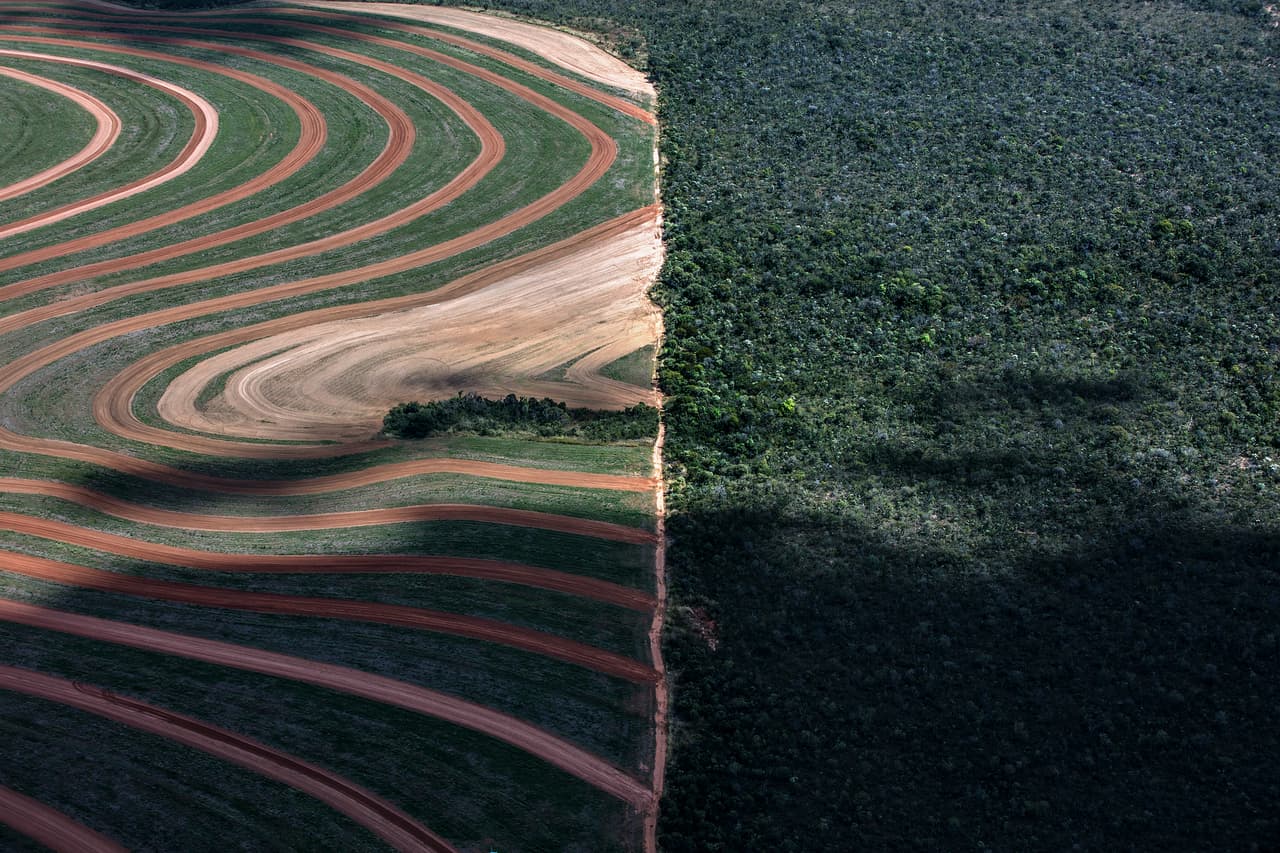
Exploiting the global south
In the wealthy global north, Cargill’s negative impact has been largely limited to food contamination and environmental pollution. But the global south has experienced the more wide-reaching effects of commodity agriculture.
Perhaps most shockingly there has been an allegation that a farm supplying Cargill has used child enslaved labour. Cargill denies any wrongdoing.
Over two thirds of the world’s cocoa is produced by smallholders in west Africa, and Cargill is one of the world’s largest traders of the commodity. In December, the US supreme court is scheduled to hear a case, first filed in 2005, alleging that Cargill was one of two major companies to have “aided and abetted” child slavery in west Africa. Six cocoa farmers allege that they were trafficked as children in the 1990s from Mali to Ivory Coast, where they were forced to work unpaid on plantations and severely physically abused by guards. Cargill is defending the claim against it.
International Rights Advocates (IRA), which is representing the claimants, alleges that Cargill knew that the farms it was using were accused of exploiting child slaves, yet continued to do business with them.
“Cargill [is] asking the supreme court to overrule centuries of law, and hold that corporations are immune from human rights crimes under international law,” Terry Collingsworth, executive director of IRA, told Unearthed. Cargill did not respond to a request for comment.
Last year Cargill announced a $113m investment to expand its cocoa processing sites in west Africa, including $12m to improve traceability and sustainability of supply chains, including measures to tackle slave labour.
Like soya, the cocoa trade has driven the destruction of forests. A 2017 Mighty Earth investigation found that cocoa purchased by Cargill and others via a series of third parties had been grown in illegally deforested protected areas in Ivory Coast. In 2017, Cargill pledged to immediately end sourcing from national parks and to restore forests in Ivory Coast and Ghana. But Mighty Earth reported that: “A year later … we found that in many places, deforestation had actually increased since Cargill announced its commitment.”
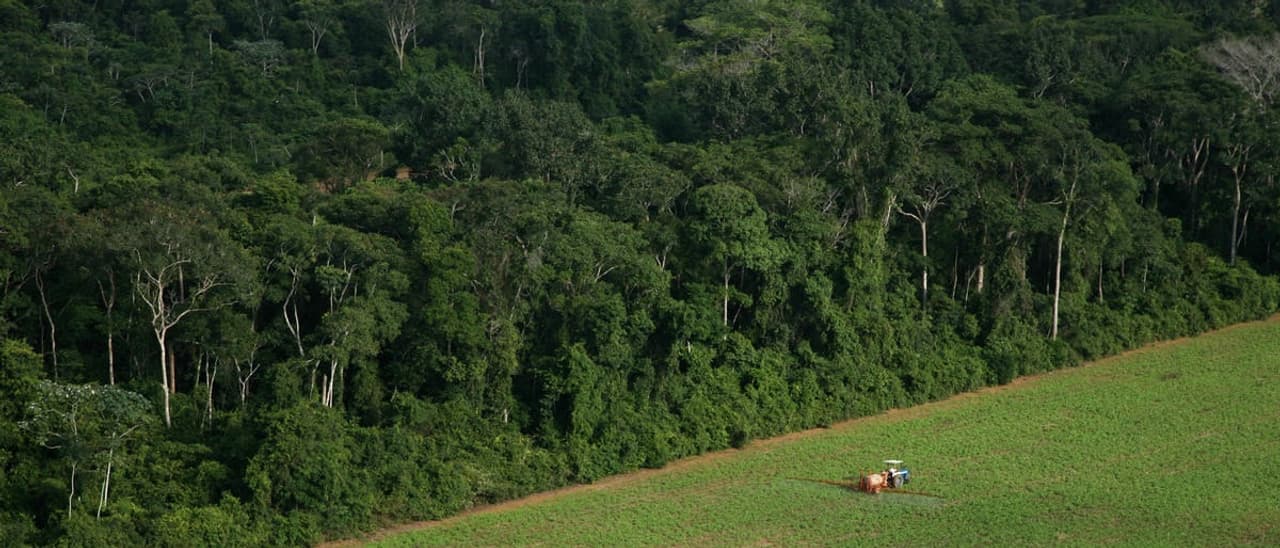
Agribusiness on the scale of Cargill’s tends to benefit wealthy and well-connected producers, and requires huge tracts of land – often in countries where land tenure has historically been insecure for poor rural workers.
Highly concentrated land ownership has long been a catalyst for conflict in Brazil. In the Amazon state of Pará, Cargill’s operations – including the construction of a huge port on the Tapajós River able to ship 5m tonnes of soya per year – have driven soya development but have also been linked to concerns over local land disputes and pressure on indigenous territories.
Pará’s Munduruku do Planalto Santareno is an indigenous territory that still hasn't been formally demarcated. It is surrounded by soya and corn fields, and tribal leaders report frequent threats from farmers and land-grabbers.
In August, Chief Manoel Munduruku told Unearthed that the arrival of large-scale soya farming on their ancestral land had transformed almost every aspect of their lives: their forests had been razed, their streams had silted up and pesticides had been sprayed mere metres from their homes and crops. “We had a dignified life, with forest around us, our streams, and enough food for our people to eat,” he said. “With the arrival of agribusiness within our territory, things became much more difficult, more complicated.”
In September 2018, 10 farmers linked to the Rural Union of Santarém (SIRSAN) sued Brazil’s National Indian Foundation over the Munduruku demarcation process, claiming to own part of the land within Munduruku-claimed territory. Amazon Watch suggested that these farmers were likely to supply soy to Cargill. “All producers in our region are registered with Cargill,” SIRSAN’s president has said. SIRSAN did not reply to a request for comment.
Further south, Cargill sources soya from tenant farmers on Agronegócio Estrondo, a sprawling estate twice the size of Greater London at the heart of the Cerrado soya deforestation frontier in western Bahia. Families who have lived on the land for more than a century say the Estrondo estate has in effect corralled them into a valley, criss-crossing the land on which they used to freely forage and graze animals with fences, and there have been allegations of violence by private security guards. Brazil’s land reform agency has raised concerns over aspects of the original purchase in 1978; if validated, it could be one of the biggest land-grabs in Brazilian history.
Estrondo said it disapproved of acts of violence. A spokesperson said: “In 2010, a private security company was hired to provide property security for the project and ensure the safety of workers and residents of the project, when they became victims of invasions, thefts and destruction.” It added that disputes over the land were still going through the courts.
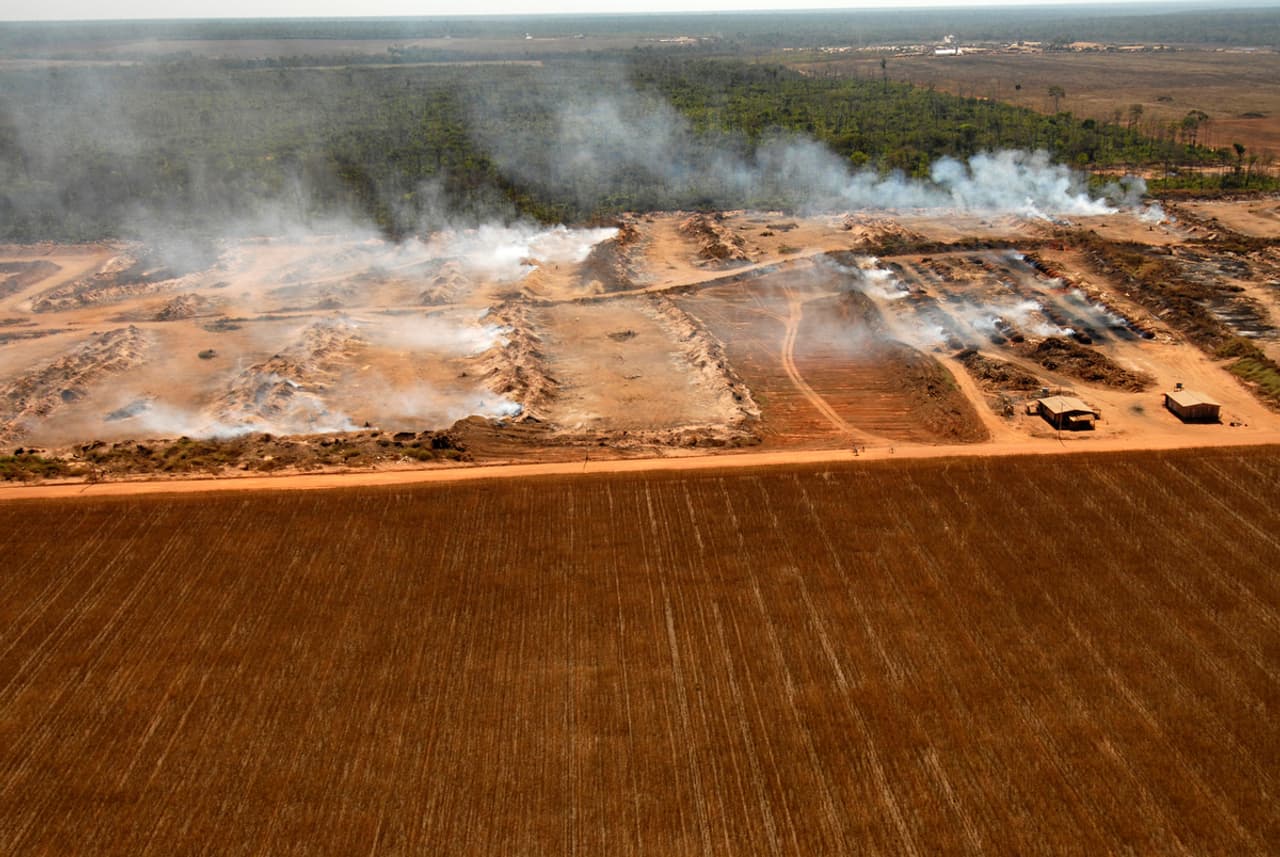
Full pockets, empty promises
Looking over its history, it seems astonishing that Cargill is not more well known. But the company is a master at managing information, not least its own public profile. The image of the plucky family firm striving to feed the world is one Cargill has cultivated for decades, said Lansing. “It has taken on different guises from the 1960s but the message is basically the same: ‘We are doing the world a favour.’”
If you haven’t seen Cargill’s sustainability promotional video from 2017, you can probably imagine what’s in it. It cuts together shots of cheerful farmers all over the world, examining soya beans and striding through sunlit crops, punctuated by images of verdant landscapes. The music is swelling, optimistic, bland. It lists Cargill’s four priorities for building a sustainable future: climate change, land use, water resources, farmer livelihoods. It is convincing.
Campaigners say there is a real and present danger in this approach. Cargill may be under pressure to operate sustainably but for the pressure to be effective it must have commercial consequences: it must come from Cargill’s customers. Yet Cargill talks so much about sustainability that its customers – the shops and restaurants where we buy our food – may well believe the job is already done.
“It has been really hard for us, no matter how much evidence we assemble about deforestation, for customers to believe it,” said Hurowitz. He believes Cargill’s greenwashing has been very effective in influencing the way consumers perceive the company.
Header image: A soya farm in the Cerrado. Courtesy of Marizilda Cruppe/Greenpeace.
Infographics designed by Unearthed.
Our Food and Farming project is partly funded out of Bureau core funds and partly by the Hollick Family Foundation (for 2020) and The Guardian. None of our funders have any influence over the Bureau’s editorial decisions or output.





